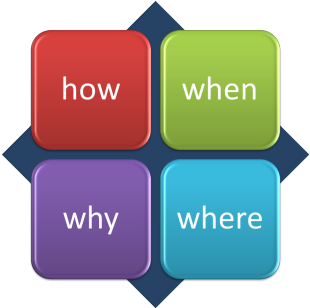Adverbials: the essentials

Adverbials are words or phrases which tell us more about the verb.
For example:
John walked
is a perfectly comprehensible sentence standing alone. However,
John walked quickly to work this morning because his wife
had the car
tells us much more about the verb walk including:
where John walked (to work)
how he walked (quickly)
when he walked (this morning)
why he walked (because his wife had the car).
 |
What's the difference between an adverb and an adverbial? |
The short answer is that all adverbs are adverbials but not all
adverbials are adverbs.
This is what is meant:
The term adverb refers to a class of words in English which function as adverbials. For example, all the words in black in these sentences are adverbs and they are all functioning as adverbials (because that's what adverbs do):
- She frequently contradicts me
- Mary went slowly into the room
- They greatly enjoyed the party
- He looked upwards
- He is coming soon
- They arrived late
Many adverbs in English are formed by adding -ly to the adjective (slow → slowly etc.) but as the last three examples show, this is not always the case and adverbs cannot always be recognised by what they look like; we have to identify what they do.
There is a separate guide to adverbs on this site linked in the list of related guides at the end which will tell you more about adverbs in general. What follows here concerns some other forms of adverbials.
 |
3 types of non-adverb adverbials |
Apart from adverbs, English has four main ways of modifying (i.e., adding information to) a verb.
 |
Prepositional phrases |
| Go over the bridge |
Prepositional phrases are formed by the preposition (over, under, round, through, by, before, after, to, from etc.) and its complement (or object) which is usually a noun phrase. Like this:
| Preposition | Noun-phrase complement / object | Example | Function |
| before | lunch | They went for a walk before lunch | a time adverbial adding information to went for a walk |
| to | my house | She came to my house | a place adverbial adding information to the verb came |
| round | the shopping centre | They walked round the shopping centre | a place adverbial adding information to walked |
Often, in almost all languages, sentences will contain a combination of
prepositional phrases which each supply different sorts of extra
information about the verb so we can have, for example:
He walked over the hill
to my house in the morning
which contains three prepositional phrases:
over the hill
(a prepositional phrase adverbial of place, specifically
direction)
to my house
(ditto)
in the morning
(a prepositional phrase of time)
It is important that you know that the prepositional phrases in, for
example:
She went to the house
on the corner
are not both adverbials because
to the house
tells us where she went and is an adverbial but
on the corner
does not tell us where she went, it tells us where the
house is so it is modifying the noun, not the verb.
Prepositional phrase adverbials normally tell us when
or where (i.e., they are time or place adverbials).
That is not always the case because they can tell us other things.
For example:
She spoke in French
tells us how she spoke, not where or
when.
 |
Noun phrases |
| He lives next door |
Noun phrases as adverbials are not very common but there are times
when we do not need a preposition and the noun phrase can stand alone to
tell us more about the verb. Here are three more examples:
He arrived yesterday
evening (a noun-phrase time adverbial)
He speaks a great deal
(a noun-phrase adverbial of extent)
They went home
(a noun-phrase adverbial of place)
Be careful here not to confuse noun phrases acting as the object of
the verb with noun phrases acting as adverbials or modifying another
noun. For example, in:
She bought the house next
door
the phrase next door is
not an adverbial, it is modifying the house, not the verb.
 |
Clauses |
| Spending time where she likes |
A clause, by some definitions, is a group of words which contains at least one verb.
Clauses can act as adverbial in many ways: how, where, when
and why. For example:
They are doing it the
way I told them to
tells us how they are doing it
I am living happy where
I want to be
tells us where I am living
She went to the cinema
after she left work
tells us when she went
He asked because he
needed the money
tells us why he asked
Clauses can also tell us other things about the verb. For
example:
They will come
if they have time
tells us what the coming is dependent on
She went to the party
although she was feeling ill
tells us what is conceded
He speaks French as
well as he speaks German
compares two verb phrases
and so on.
However, these sorts of adverbials are usually analysed and taught from
the point of view of the conjunctions (if, although, as well as
etc.).
There are a number of guides on this site which consider the forms of adverbials separately. For the in-service guide, which contains much more technical information and has links to other areas, use the first link below.
| Related guides | |
| adverbials | for the in-service guide which is much more technical and detailed |
| adverbs | for the essential guide to this word class |
| prepositions | for consideration of how preposition phrases work |
| prepositional phrases | for more in the in-service section |
| conjunctions | for more on the way clauses are connected |
